The time has long passed when the attic was just an attic, and only old rubbish was lying in it. They almost never looked in there, since this room was non-residential, and in the winter season it was not heated, and it was cold.
But now there are many different materials that can turn the attic into a useful living space. It can be used to the maximum benefit, having arranged from the attic a warm billiard room, additional rooms and much more.
But to make this possible, you need coolness in the attic in the summer, and warm in the winter. Therefore, the importance of a roofing cake cannot be overestimated, because it serves to maximize the achievement of these goals.
Let us consider in more detail what is a roofing cake, what is its purpose, design options, as well as differences in installation for different building materials to cover the roof.
Content
Roofing cake device in details
Roofing pie is a special filling in the composition of the roof, which carries the functions of thermal insulation, and also has waterproofing properties. A layer of vapor barrier for the roof is vital. Its function is to prevent the penetration of moisture (in the form of precipitation) into the insulation, and fix this layer indoors.

When laying these layers, it is necessary to carefully glue the joints between them, since if this is not done, then moisture can penetrate inside. Another undesirable consequence of non-glued joints can be a significant heat leak from the room.
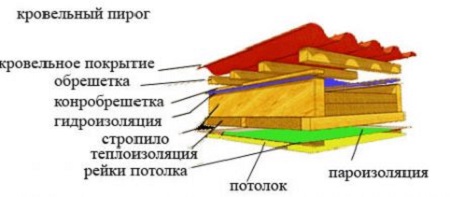
A waterproofing layer is usually laid over the insulation. It also serves to prevent moisture from entering. Such reliable protection is also made to prevent the accumulation of condensate inside. To prevent this from happening, on top of the roofing “pie” you need to reserve a little roof space.
The space under the roof should not be too much, but not too small (at least 50 millimeters). This space is made for better ventilation, so that air flows form.
Here are the basic elements of the whole structure:
- reliable rafter system;
- vapor barrier layers;
- there must certainly be a layer of insulation, which at the same time performs its heat-insulating functions;
- then you need to lay a waterproofing film;
- also important elements are crate and counter-crate;
- then you can lay roofing material;
- and finally, the future catchment system must be planned.
The three most common options for roofing "pie"
In the conditions of Russian winters, care must be taken to ensure that the insulation layer is sufficiently thick. Best if the thickness is between 150 and 200 millimeters. The insulation must be laid so that where the junction of the layers passes, one could overlap with the other.
This method optimally prevents the appearance of the so-called “cold bridges”. The selection of the required thickness of the insulation is also needed in order to smooth out the noise of precipitation from rain or hail.
It is worth saying that the structure of roofing pies for different coatings varies quite slightly. However, these differences mainly relate to the base on which the roof is fixed. Most often, a continuous crate is used for soft tiles, and for a metal tile, a crate is used, in which the course of the wave is taken into account. If composite tile is used, then a certain step of the crate is needed.
All the design features of roofing pies will be described later in this article. Let's start with an important acquaintance with the options for the structure of the roofing pie.
Cooking the roofing cake at number 1
In the first embodiment, it is assumed that the insulation should be at least 150 millimeters thick. The ventilation clearance must be at least 50 millimeters. The waterproofing film is not used at all in this puff cake. The rafter system must have certain dimensions (for example, 200 x 50 millimeters).

Often the insulation can swell. To prevent this from happening, you need to integrate a special limiter for the insulation into the system.
Cooking the roofing pie number 2
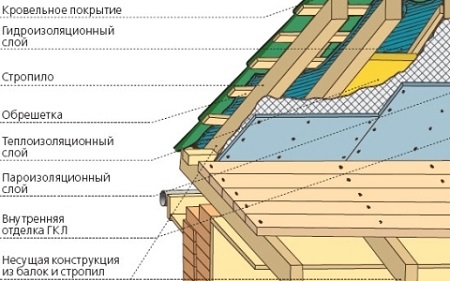
The second option is considered to be the most common today: 150 mm rafters are installed, a vapor barrier film is laid from below, which should limit the insulation, and all this is covered with a windproof film from above.
On top of the rafters build a counter-lattice. Its installation should be carried out in such a way that a ventilation channel is formed.
Then they do not lay a continuous crate, but the last step is laying the base of the roof.

This method is not ideal, since in this case cold bridges may form where the joint of the rafter system and the insulation occurs.
The third option is almost perfect
Here the fourth layer is laid insulation. This layer can significantly save money on heating a house.
To improve the insulation properties, it is recommended to use a heater, which includes basalt. Then, a waterproofing film is laid on the insulation, which solves some problems, for example, such as:
- reduction in the total thickness of the roofing cake;
- the insulation with this method of laying breathes, and the film allows the moisture that has penetrated into the insulation to erode freely.
In this case, the vapor barrier materials in such a pie will be reliable protection against leakage of any moisture and other liquid substances into the insulation. It is worth remembering that the vapor barrier in this case needs to be mounted on the inside of the rafter system, overlapping it. Where the joints of the film pass, you need to process with duct tape.
Roofing Pie for Soft Roofing, basic installation rules
Where do you need to start installation in the first place? You should start with laying between the rafter system of the insulation. In this case, it is worth considering the width of the selected insulation, it can be different, but, basically, it is 60 centimeters. Only starting from this, it is necessary to determine the desired step of the rafters.
After completion of the laying of the insulation, it is necessary to fix the vapor barrier sheet from the side of the interior under the roof, and then it can be closed with boards.
Later, this frame can be used for interior decoration, stitching it with drywall or other similar material (for example, lining).
As for the outside of the roof, then after laying the insulation material, it is necessary to lay waterproofing, which can be fixed with a special beam having a cross section of at least 50 x 50 millimeters.
After all this, a layer of crate is laid. As a material for the crate, you can use a board whose moisture content should not be higher than 20%.

Boards for lathing must be impregnated with protective compounds before laying.
It is also worth remembering the “golden rule”: the more the rafter pitch is set, the thicker the boards that are needed for the construction of the lathing should be.
If a roofing cake is created under a soft tile, then it is imperative to make the roof lathing a uniform solid surface.
Well, the final step will be the laying of roofing material on the crate.
Roofing pie under a metal tileinstallation rules
To make the roof right, you need to take into account every detail, even if at first it seems insignificant. When creating a roof from a metal tile, it is necessary to approach its construction with extreme responsibility and take into account all the nuances of its construction.
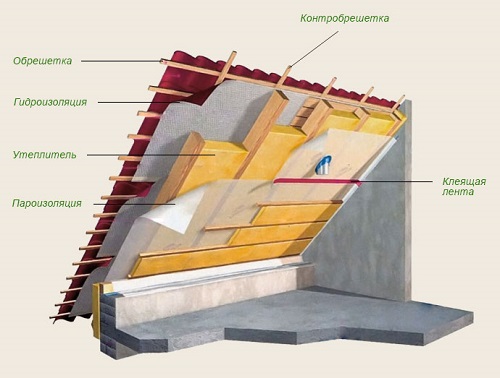
In order for the installation process of such a material as a metal tile to go in the best way, it is preferable to install a roofing pie under a metal tile on a cold roof.
Without considering the supporting structures, the pie consists of several materials, as well as a counter-lattice and a waterproofing film installed under it.
It is better to fix the film with small nails or use staples, a construction stapler. For final fixing use self-tapping screws.
It is also necessary to make a special "sagging" throughout the film, which should be from 15 to 25 millimeters. This will make ventilation of the lower side of the sheets much better, and it will also be most effective to drain the accumulating condensate into a special cornice strip, and only then - into the gutters.
Such measures must be applied necessarily. If you do not make this slight sag, but rather, make a very strong tension, then moisture will accumulate on the surface of the entire film, as a result of which the elements of the entire structure (especially its metal parts) will corrode.
As for the lathing, then on top of it, along the whole slope, you need to fill the same lathing boards, to which the sheet will subsequently be fixed.
However, a cold roof is not very popular lately. And there are reasonable explanations for this. Under the cold roof, the attic is poorly insulated, it becomes non-residential, and the noise from rain and other precipitation will not allow you to comfortably spend time in the attic.
Therefore, most often in residential country houses a warm roof is installed. It is much better insulated and allows almost 100% use of attic rooms, making them more soundproof and suitable for living.
Of course, the installation of a warm roof requires a lot more building materials, and the cost of installing a roof made of metal can grow quite significantly, but these costs more than pay off for comfort and coziness.
The functionality of such an attic can increase so much that you can make rooms or other household premises without having to build an additional floor, but using only the attic's capabilities.
Consider one of the most important layers in the whole "pie" - a layer of waterproofing. Why is it needed, the main types and types, as well as its functional purpose - these are the questions that we will try to answer.
Roofing pie waterproofing
The waterproofing materials used depend on the type of roof covering. Moisture can penetrate the attic from the street in rainy and snowy weather. If the attic space is not used for residential purposes, but ventilation is provided, then the moisture is eroded and does not create much trouble.
However, there is still the possibility that the wooden elements of the base of the roof may be spoiled. This is facilitated by the small amount of steam, which sometimes still penetrates into the insulation.
Layers of waterproofing are necessary precisely for these reasons. They depend on the type of roofing materials: absorb or pass steam.

Do not confuse when laying a waterproofing film on its side: one is intended for connection with a heater, and the other with roofing material. Otherwise, such a roofing cake device will not give the desired effect.
Types of waterproofing for roofs
Vapor permeability special superdiffusion membranes very high, so they are always installed close to the insulation. Water vapor is able to pass through these superdiffusion membranes, but water cannot.
This option is not used in combination with metal tiles and euro slate, since their reverse side is not intended for contact with moisture. The membranes are attached to the rafters with the help of a counter beam, after which they are also mounted on the crate.
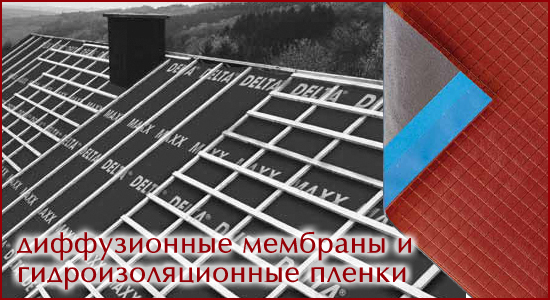
Structure necessary for normal operation in the presence of 2 ventilation gaps (upper, lower). Typically used for bitumen-based roofing or on tiled roofs.
Such membranes are films with tiny holes having the shape of a funnel and facing the wide side inside the room. They let steam through, trap moisture from the outside. So that the holes do not clog and let steam pass, there should be no contact of the material with the insulation.
Condensate is removed through the ventilation gap between the waterproofing and the roofing material (with a soft roof, between a continuous crate). Such membranes are applicable only in combination with roofing materials, whose reverse side is not afraid of contact with moisture.
For work with a metal tile and euro slate use waterproofing condensate filmwhich is absolutely vapor tight.
It is necessary to have 2 ventilated gaps. The fleecy surface of the side of the film that faces the insulation has the property of retaining condensate. The other side of the roof covering, which is ventilated by the upper channel for air movement, is completely protected from moisture.
So, a roofing cake is an important part of the roof structure, which means you should not save on its “filling”. It would seem that small violations of technology should not greatly affect the quality of the roof, but, alas, this is not so. By following all the rules and regulations when creating it, you not only reduce energy costs, but also increase the life of the roof of your house.

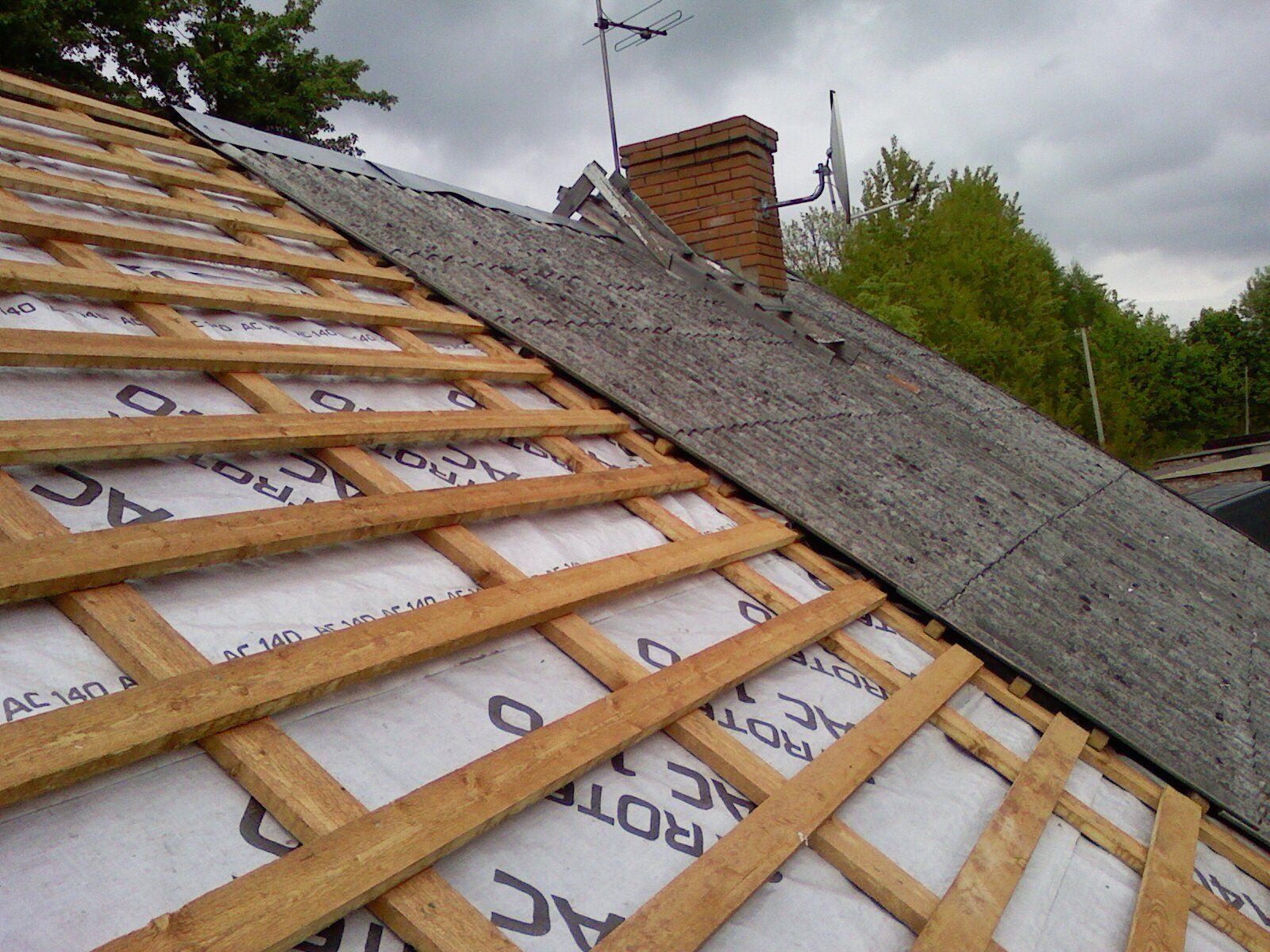



Alas, no comments yet. Be the first!